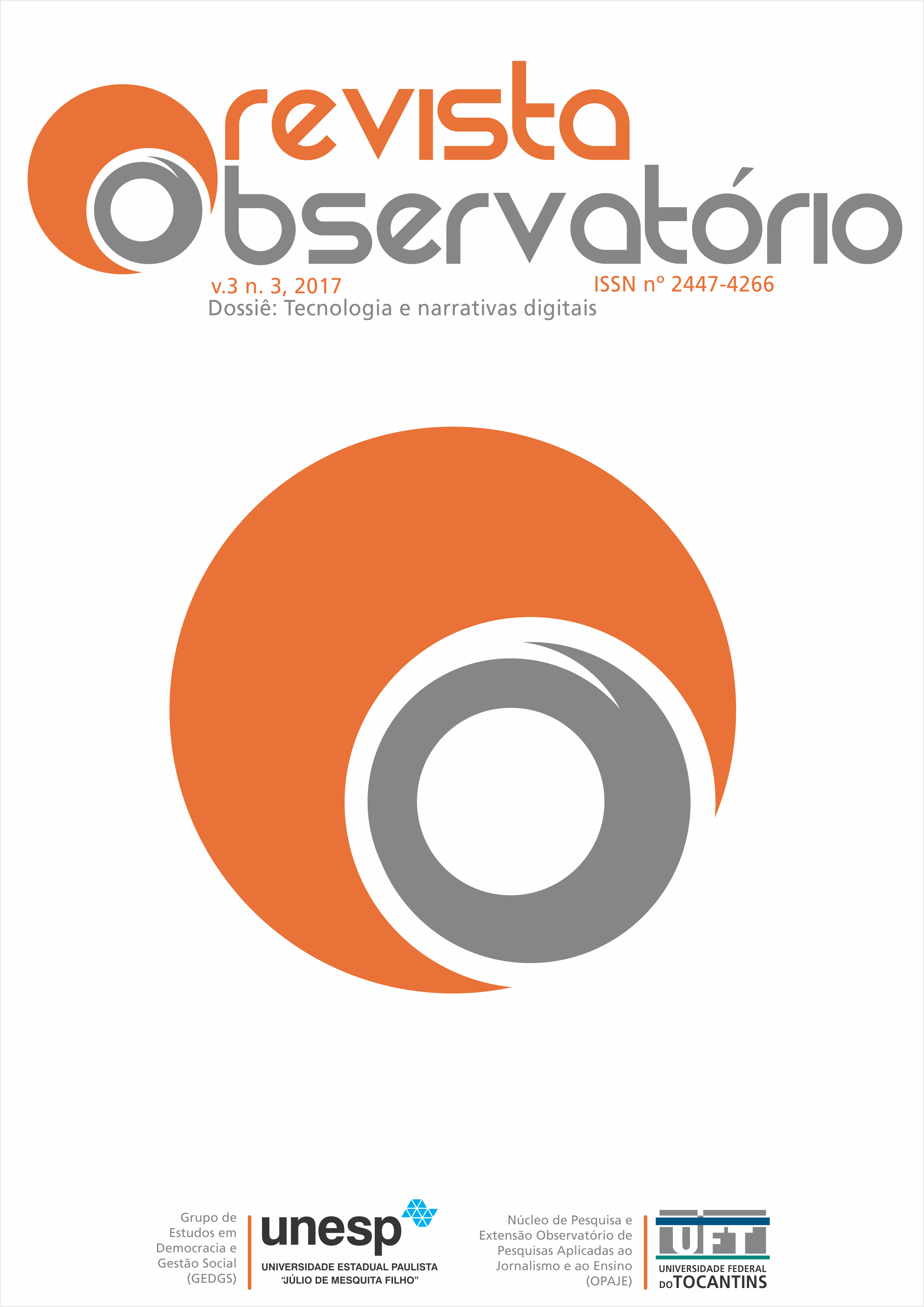LOCATION-BASED JOURNALISM: The Breaking News case
DOI:
https://doi.org/10.20873/uft.2447-4266.2017v3n3p229Keywords:
Ciberjournalism, Geolocation, Breaking News, Location-Based SystemAbstract
The consumption of news in online media is mostly made from the chronological placement of stories, from the search for specific topics, or by reading what is considered most important by the editor and put in the spotlight. Consume news at the person's geographic location filter is a new opportunity created by Location Based Systems, which gathers the internet, the geographical position systems technologies for mobile communications devices. To start a review about it here called Journalism Based on location, the example of Breaking News news website is presented and how it has been using these resources.
Downloads
References
BREAKINGNEWS. Inside Breaking News. 2011. Disponível em:
http://blog.breakingnews.com/post/9309027307/fake-news-thriving-in-social-media-this-may-not , Acesso em: 15 de out. 2015.
________________ Introducing proximity alerts and much more in the new Breaking News iOS app . 2014 DIsponível em:
http://www.breakingnews.com/about/. Acesso em: 18 de out. 2015.
________________. About Us. 2015 DIsponível em: http://www.breakingnews.com/about/. Acesso em: 15 de out. 2015.
BRIMICOMBE, Allan, and LI, Chao. Location-Based Services and Geo-Information Engineering. Hoboken, NJ, USA: John Wiley
& Sons, 2009. ProQuest ebrary. Web. 2 September 2015.
CURRIE, Timothy. Experiments in Location-based Content: A Case Study of Postmedia’s Use of Foursquare. 2011. Presentation at the International Symposium in Online Journalism, Austin, TX, April 1–2, 2011. Disponível em: https://online.journalism.utexas.edu/2011/papers/Currie2011.pdf, acesso em 28 de out de 2015
ELLIS, Justin. The notification knows where you are: Breaking News debuts news alerts tied to your location. NiemanLab. 2014. Disponível em: http://www.niemanlab.org/2014/06/the-notification-knows-where-you-are-breaking-news-debuts-news-alerts-tied-to-your-location/ Acesso em: 26 de out de 2015.
GOGGIN, Gerard, MARTIN, Fiona, e DWYER, Tim. Locative News: Mobile Media, Place Informatics, and Digital News2. 015
Journalism Studies 16 (1): 1–19. Disponível em: http://www.tandfonline.com/doi/abs/10.1080/1461670X.2014.890329. Acesso em 28 de out de 2015.
LÉVY, P. A inteligência coletiva: por uma antropologia do ciberespaço. 4.ed. São Paulo: Loyola, 2003.
LICHTERMAN, Joseph. Push it: How Breaking News notifies users of news stories before they become big. NiemanLab. 2015. Disponível em: http://www.niemanlab.org/2015/08/push-it-how-breaking-news-notifies-users-of-news-stories-before-they-become-big/ Acesso em: 26 de out de 2015.
NYRE, Lars, Bjørnestad, SOLVEIG, Tessem, BJORNAR, e ØIE, Kjetil. Design and Evaluation of a Location-Based Mobile News Reader. 2011 New Technologies, Mobility and Security (NTMS), 2011 4th IFIP International Conference on. Disponível em: http://ieeexplore.ieee.org/xpl/articleDetails.jsp?arnumber=5720634&filter=AND(p_Publication_Number:5720565) Acessado em 28 de out de 2015.
OPPEGAARD, Bret; RABBY, Michael K. Proximity, Revealing new mobile meanings of a traditional news concept, 2015. Digital
Journalism DOI: 10.1080/21670811.2015.1063075
PAINE, Emory, The Next Step: Social Media and the Evolution of Journalism (2015). Honors eses. Paper 53.
REINO, Lucas Santiago Arraes. Jornalismo baseado em localização: Uma análise das potencialidades na produção e no consumo de notícias. 2015. 249 f. Tese (Doutorado) - Curso de Comunicação Social, Faculdade de Comunicação Social, Pontifícia Universidade Católica do Rio Grande do Sul, Porto Alegre, 2015.
RHEINGOLD, Howard. Smart Mobs. Cambridge: Perseus Publishing, 2003.
ROSEMBERG, Howard, FELDMAN, Charles . No Time To Think: The Menace of Media Speed and the 24-hour News Cycle. 2008. Bloomsbury Publishing USA, 240p.
Downloads
Published
How to Cite
Issue
Section
License
[PT] Autores que publicam nesta revista concordam com os seguintes termos:
1. Autores mantém os direitos autorais e concedem à revista, sem pagamento, o direito de primeira publicação, com o trabalho simultaneamente licenciado sob a Creative Commons Attribution License (CC BY-NC 4.0), permitindo o compartilhamento do trabalho com reconhecimento da autoria do trabalho e publicação inicial nesta revista.
Leia todos os termos dos direitos autorais aqui.

